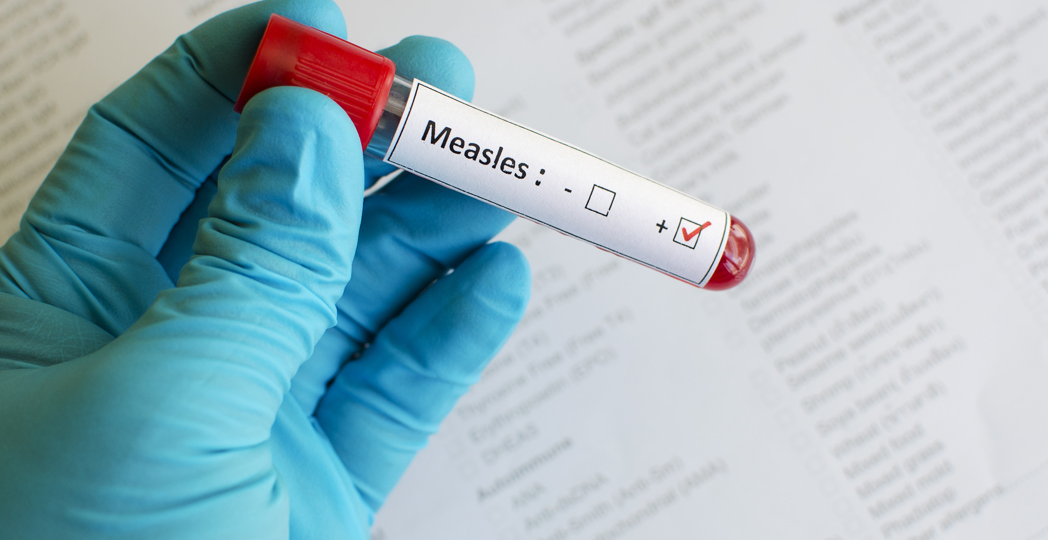What to Know: Measles Outbreak in Ohio
by Danny Cunningham | Apr. 17, 2025 | 7:00 PM

iStock Photo
Measles have been in the news lately.
With vaccination rates falling, more people have become infected with the virus, particularly children. According to the CDC, there have been 607 confirmed cases – as of April 3 – of measles in the United States since the calendar turned to 2025. Those cases have been spread across 22 states, including Ohio.
Cleveland Magazine caught up with infectious disease physician Dr. Donald Dumford of the Cleveland Clinic to ensure that we’re as educated as possible about this current measles outbreak.
Cleveland Magazine: Why are we talking about measles so frequently right now?
Dr. Donald Dumford: We know that when you look at measles, to be able to protect against spread within a community, because it's so contagious, you have to have 95% of the population in that community immune or vaccinated. And we know that probably for about the past five to 10 years, we've seen declining numbers for vaccinations throughout the country. If you look at it across the states, about a quarter of the states are above that 95%. About a quarter of the states are below 90%, and then half the states are in that 90 to 95% range. I think really just with reducing levels of vaccination, that's allowing for the spread of disease in communities once it's introduced.
RELATED: What to Know About Bird Flu in Ohio
CM: What is the vaccination rate in Ohio currently?
Dumford: I believe it's 92%
CM: What exactly do the measles do to people when they get it?
Dumford: The average person, after that exposure, it usually takes seven to 14 days to start to manifest symptoms. Your first three days of symptoms are going to be fever, cough, because it is an infection that affects the lungs as well as the rest of the body. You're going to see people get watery eyes or conjunctivitis, and then they typically have inflamed nasal passages. So that's usually we say fever and the three C's: cough, coryza, which is that inflamed nasal passages, and then conjunctivitis that typically lasts for about three or four days. By that point, people are very contagious. After that, a rash comes on that lasts for about a week, and then at that point, people start to recover from the illness. Typically, people are contagious four days before and four days after the rash, and then all during the time that the rash is present. The average person has a self-limited illness and recovers, but we know that with 20 people who have measles, about 5% of them will get hospitalized, and about one in 20 people will develop pneumonia. The really severe outcomes include brain infections happening about one to three out of every 1,000 kids that get it usually, and death can occur in about one to three out of every 1,000 cases, either from that brain infection or sometimes from severe pneumonia. There's also another sort of, we'll say, sneaky complication where people might get better, do fine, not have any problems with the initial measles. But then eight-to-10 years later, they develop this progressive brain complication called subacute sclerosing panencephalitis, where inflammation in the brain occurs again and leads to cognitive decline. That happens very rarely but is still something to consider.
CM: Considering what we just dealt with within the last five years, and obviously this is now popping up but is something that we know about. Is there concern that this could be something maybe not quite at the same level as the COVID-19 pandemic, but something that could become much more widespread than it currently is?
Dumford: This is not going to look anything like COVID. I think with the way that the vaccination rates are now, if we look at the different areas that we're dealing with right now, like in Texas, New Mexico, Oklahoma, Kansas and those are all kind of tied together. They expect that the outbreak is going to continue to go on for probably the rest of the year. Still, we're going to be looking at an overall probably less than a thousand, less than two thousand people affected overall. So it's not going to be like COVID, where we were seeing hundreds of people every day in just Cuyahoga and Summit County getting infected.
CM: What if you are vaccinated and you're in a situation where you come into contact with somebody that has measles?
Dumford: Probably the best thing to say is, you pat yourself on the back and say, ‘I'm really glad I've got antibodies and I'm very, very, very, very unlikely to get this.’ If you have a measles exposure, the vaccine itself continues to provide protection. We think lifelong. There's been some studies that have shown a little bit of a dwindling of antibody levels as we get older, but even in those people, they're still protected from getting measles. If you look at the data, especially if you look at Texas right now, they've got 400 cases and only two of those people are folks who have been vaccinated before. I think if you've been vaccinated and you get exposed, it's reassuring that you're well-protected.
CM: What if I was not vaccinated as a child but would like to be vaccinated as an adult?
Dumford: If you are one of those people who has not been vaccinated, you can go to your doctor and ask for a vaccine now and you would do two doses, spread at least four weeks apart, and then that would be the way to immunize somebody who's beyond that six-year-old mark to get them vaccinated.
CM: What else do Northeast Ohioans need to know?
Dumford: I know there's a lot of rumors and misinformation out there. It's just an insanely safe vaccine. There are very few severe complications from it, and we don't really see that happening very often or at all. I think the other thing is a lot of people have tied it to autism, and there was a study that had tied it to autism, but they found that it was actually a fraudulent study. A great number of other studies have shown that there's not a link between the two.
For more updates about Cleveland, sign up for our Cleveland Magazine Daily newsletter, delivered to your inbox six times a week.
Cleveland Magazine is also available in print, publishing 12 times a year with immersive features, helpful guides and beautiful photography and design.
Danny Cunningham
Danny Cunningham has worked with Cleveland Magazine since October 2024 after previous stops at ESPN Cleveland, SKOR North and Complex Sports. He also is the host of the Locked On Cavs Podcast and runs a Substack, The Inside Shot, which covers the Cleveland Cavaliers.
Trending
-
1
-
2
-
3
-
4
-
5










